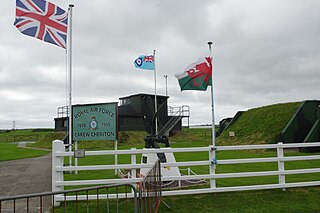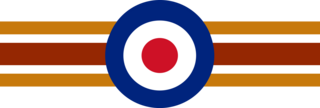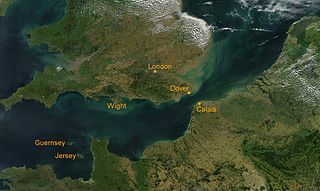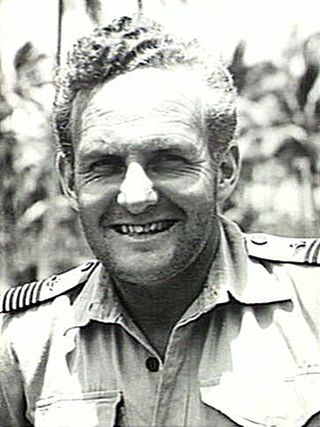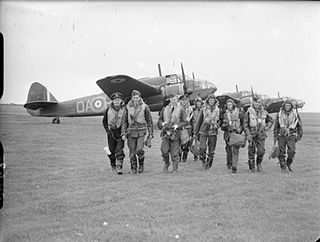World War II
No. 217 Squadron was re-formed under the recently created RAF Coastal Command on 15 March 1937, based at RAF Boscombe Down. [3] [2] [4] Equipped with Avro Ansons, the first RAF monoplane with retractable undercarriage, the squadron performed general reconnaissance duties until the outbreak of World War II. [3] It moved between different stations at RAF Tangmere, RAF Warmwell and RAF Bicester until October 1939. [3]
English Channel Operations
In October 1939, No. 217 Squadron moved to its brand-new war station at RAF St Eval on the north Cornish coast, which it occupied in an unfinished state. [2] [4] Its Avro Ansons conducted anti-submarine patrols [3] over the Western Approaches to the English Channel. [2] [4] From May 1940, the squadron started to be equipped with the Bristol Beaufort torpedo bomber, but serious problems with the new aircraft's Taurus engines meant that the Avro Ansons remained in service until December 1940. [2]
The Bristol Beauforts started to see active service from 24-25 September 1940. [4] [2] They were used in anti-shipping and mine-laying missions. Torpedo attacks were difficult because the aircraft had a tendency to roll, the height of weapon release meant that the distance to target was hard to judge and the aircraft were forced to overfly their target ships, rather than expose their belly to flak by turning away.
One such anti-shipping mission set out on 12 February 1942 to intercept the German battleships Scharnhorst and Gneisenau as these fled from their safe haven at Brest, making the daring Channel Dash for Germany. [4] No. 217 Squadron had a detachment of four Beauforts that were ideally placed at RAF Thorney Island, near Portsmouth. On their first sortie, two aircraft made contact with a different warship, believed to be the German cruiser Prinz Eugen but their torpedoes missed. On their second sortie, the same pair found the Scharnhorst but their torpedoes missed again. The other two Beauforts reached the French coast, after misdirection due to a mix-up over radio frequencies. [4] A later sortie by the remaining aircraft from RAF St Eval only found four small minesweepers. [4]
In February 1942, the squadron moved briefly to RAF Skitten and then RAF Leuchars in Scotland, where they conducted few operations, as they were being earmarked for duty in Ceylon. [3]
Mediterranean Operations
In May 1942 the squadron was ordered to Ceylon, via Gibraltar and Malta. The ground echelon left on 7 May 1942, [3] with orders to proceed directly to the Far East, [4] and the aircraft followed on 7 June 1942, [3] arriving in Malta on 10 June 1942. [2] However, many of the Bristol Beauforts were found to be unserviceable on arrival, having problems with their torpedo loading and dropping mechanisms. All nine aircraft were grounded for repairs. [2]
The aircraft were detained in Malta, in order to provide cover two for Allied convoys that were to resupply Malta from both ends of the Mediterranean in June 1942. [4] Operation Harpoon sailed eastward from Gibraltar, while Operation Vigorous sailed westward from Alexandria. On the morning of 15 June 1942, a force of eight Bristol Beauforts attacked an Italian fleet that was steaming south, seeking to intercept the convoys. [5] A single torpedo from one Beaufort [5] [6] crippled the Italian cruiser Trento, which was later sunk by the British submarine HMS Umbra (P.35). [4]
On 21 June 1942, eight Beauforts of No. 217 Squadron flying out of RAF Luqa located and attacked an enemy convoy, scoring two hits on each merchant vessel and one possible hit by one of three Beauforts which failed to return. [7] On 23 June 1942, twelve Beauforts of No. 217 and No. 39 Squadrons attacked four destroyers and two large merchant vessels, scoring three hits and one probable hit on one merchant ship and two hits on the other, immobilising the ships. One aircraft of No. 217 Squadron crashed on landing; two from No. 39 Squadron failed to return. Three aircraft were slightly damaged by anti-aircraft fire. [7]
In another incident, on 28 June 1942, the crew of a ditched Beaufort were rescued by an Italian CANT Z.506 seaplane. The rescued crew overpowered their Italian rescuers and the CANT was flown to Malta where the Italians were made prisoners of war. [8]
No. 217 Squadron remained on Malta for two months, carrying out anti-shipping attacks across a wide section of the Mediterranean, reaching as far as Greece. [4] These missions were very costly in terms of materiel and crew. On 3 July 1942, a mixed force of seven Bristol Beauforts escorted by five Bristol Beaufighters flying out of RAF Ta Kali was due to assault an Italian convoy south of the island of Zante in the Ionian Sea. [2] However, two of the Beauforts failed to start; and another two were forced to turn back due to engine trouble. Of the remaining three, two of the aircraft were shot down by flak and the third aircraft, having been hit in the tail, crashed on return to Malta, with the loss of all three crews. [2] Aircrew losses were so severe, that it was thought the squadron might be wiped out entirely. [9]
Far East Operations
The surviving aircrew arrived in Ceylon in July 1942, but had no aircraft, having left their battered Bristol Beauforts behind in the Middle East. The ground crews arrived by sea in August 1942. [4] [3] Their mission was to defend the approaches to India from the Japanese navy, after successful Japanese attacks on Colombo and Trincomalee between 5-10 April 1942.
No. 217 Squadron was initially based at RAF Minneriya, an airstrip located in the east central part of Ceylon. [10] It was not until October 1942 that they started to receive Lockheed Hudsons. In November 1942, [11] crews converted from the Beaufort to the Hudson, which was used in anti-submarine patrols. [3] A detachment was sent to a location 20 km south of Colombo, to clear and construct a new airstrip at RAF Ratmalana in the jungle. [11]
In February 1943, the squadron relocated to RAF Vavuniya, [10] some 50 miles further north of RAF Minneriya, where the climate was more comfortable; and for a period, crews seemed to move between these two bases. [11] New Bristol Beauforts started to arrive in April 1943, [3] [11] whereupon No. 217 Squadron joined forces with No. 22 Squadron RAF to become a torpedo-carrying anti-shipping force; however the Imperial Japanese Navy failed to show up, as they were busy in the Pacific Ocean at the time. [11] By June 1944, it seemed that the Japanese had been deterred from attacking again. The bored crews referred to themselves jokingly as the Ceylon Home Guard. [11]
In April 1944, No. 217 Squadron relocated to the airfield at RAF Ratmalana. [10] From June-July 1944, [11] [3] they started to receive the new Bristol Beaufighter TF.X, an aircraft far better suited to maritime anti-shipping operations. The Beaufighter TF.X, affectionately known as the Torbeau, had four nose-cannon, an under-belly torpedo (or two wing-mounted bombs) and wing-mounted rocket projectiles. Their new commander, Wg Cdr John G Lingard, DFC, trained the crews in the use of rocket projectiles and raised the squadron to an effective strike unit. [11] The similarly re-equipped No. 22 Squadron was moved in a ground attack role to the Burma theatre, where Gen Wingate's Chindits had been more successful than expected. No. 217 Squadron relocated to RAF Vavuniya [10] in September 1944.
Operations Jinx and Zipper
In early 1945, a secret operation was conceived by No. 222 Group RAF in Colombo, which was later authorised by Vice-Admiral Louis Mountbatten, Supreme Allied Commander South East Asia Command. [11] The idea was to attack Japanese capital ships while they resupplied in Singapore harbour. The direct distance from Ceylon to Singapore was 2,300 miles, well beyond the range of the aircraft. However, it might be possible to fly 1,700 miles to an intermediate staging post on the Cocos Islands, a pair of volcanic atolls in the Indian Ocean, and from there to cross the 1,040 miles to Singapore, by flying over the 12,000 ft high mountains of Sumatra. This plan was codenamed Operation Jinx. [11] [12] [13]
In March, 1945 a group of Royal Engineers on Direction Island, one of the Cocos Islands, was secretly joined by an advance group of 15 airmen, later supplemented by 200 airmen in three transport ships, to prepare Station Brown, the staging post. On West Island, they cleared palm-trees from the beach and laid steel planking on crushed coral to serve as an airstrip. With Air Cdre A W Hunt commanding, the base was finished in April 1945. It was fitted out as a refuelling depot and supplied with 81 torpedoes. [11]
Unaware of this clandestine activity, groups of up to 12 Beaufighter crews practised long-distance formation flying down the east coast of India from Karachi to Colombo in Ceylon, without being told their true target. [11] To extend their range, the aircraft were fitted with an extra 90 gal fuselage tank and a 200 gal external drop-tank instead of the torpedo. Switching over sometimes led to air-locks in the fuel lines, causing two Beaufighters to ditch in the sea. Fortunately, both crews were rescued. [12]
The strike crews were told on 2 May 1945, the day before the planned assault, what the real target was. They were to attack three battleships, an aircraft carrier and several destroyers, protected by fighters from three airfields. This was clearly a dangerous, if not suicidal, mission. [11] [12] Aircraft would be lost on the 1,700 mile outbound journey to the staging post, or would be spotted flying over Sumatra and finally, if they survived the attack, the planes would run out of fuel and have to be abandoned on Phuket Island. However, on 3 May, the crews were told that Operation Jinx had been postponed, in favour of Operation Zipper , supporting the invasion of the Malayan mainland at Mountbatten's directive. Conditions had changed: there were not enough targets in Singapore harbour to be worth the sacrifice of the squadron. [11] [13]
On 22 June 1945, some air and ground crews were relocated to RAF Gannavaram on the Indian east coast in preparation for Operation Zipper . All other operations were suspended in the meantime, [11] and Operation Jinx was rescheduled for September 1945. However, the atomic bomb was dropped on Hiroshima on 6 August 1945 and Japan surrendered soon afterwards on 14 August 1945. The aircraft of No. 217 Squadron never went to the Cocos Islands. No. 217 Squadron was officially disbanded on 30 September 1945. [3] [4] [11]







